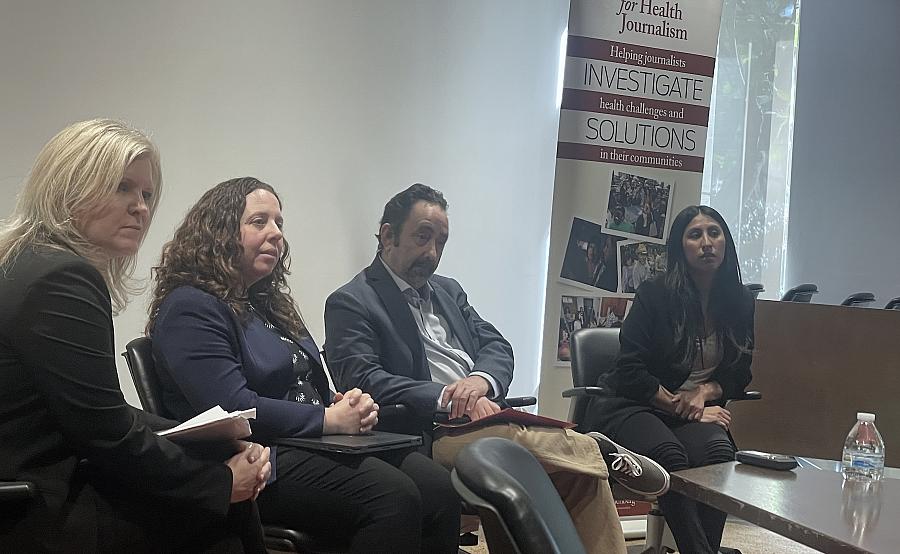Undocumented immigrants of all ages can now access Medi-Cal. Will they sign up and get care?

From left, Center for Health Journalism's Jacqueline Stenson moderates a panel on Medicaid expansion with Laurel Lucia, director of the health care program at the UC Berekely Labor Center; Bernard Wolfson, a columnist and senior correspondent for KFF Health News; and Perla Lopez, a benefits counselor for St. John's Community Health Center in Los Angeles.
Perla Lopez is benefits counselor for St. John’s Community Health Center, a federally qualified health center in Los Angeles, where she helps immigrant families and essential workers access public benefits.
Lopez helps clients find ways to gain benefits and pay for health care, including enrolling into Medi-Cal, California’s version of Medicaid. It’s a momentous year for many of the patients in her health system.
In January, Medi-Cal expanded access to undocumented immigrants ages 26 to 49, after previous rounds of expansion extended coverage to younger and older immigrants.
Medicaid is jointly funded by federal and state governments and is available to eligible low-income adults, children, pregnant women, elderly adults and people with disabilities. Generally, undocumented immigrants do not qualify for Medicaid, but in California, they are now eligible.
“I get to see that sense of relief that they don’t have to worry about seeing the doctor and getting a bill,” said Lopez, “They can get health care without hesitating.”
Lopez talked to the journalists at the 2024 California Health Equity Fellowship earlier this week about her frontline experiences at the clinic in the neighborhood where she grew up.
She immigrated to the United States when she was 1 and is a Deferred Action for Childhood Arrivals (DACA) recipient. She arrived with her mother and brother, who also lacked legal status.
Lopez said her mother, who has diabetes, qualified for Medi-Cal with the expansion for people 50 and older. Until then, her mom didn’t regularly go to the doctor because of the cost.
“Now, she says, ‘I don’t hesitate. I can just go to the clinic, get seen and get medications’,” said Lopez.
Lopez was joined by fellow panelists Laurel Lucia, director of the health care program at the UC Berkeley Labor Center, and Bernard Wolfson, a columnist and senior correspondent with California Healthline at KFF Health News, to discuss the impact of California’s Medi-Cal expansion.
“California has taken a lot of steps to make eligibility more inclusive,” Lucia said.
In 2016, California expanded insurance coverage to undocumented youth, 0 to 18. In 2020, eligibility expanded to 19- to 25-year-olds, and last year for people ages 50 and older. Adding access for adults 26 to 49 completed eligibility across the life span.
Health coverage for undocumented immigrants in California is funded by the state. Most immigrants who aren’t lawfully present are not eligible for subsidies in the federally funded marketplace, Covered California.
Previously, undocumented immigrants qualified for limited-scope Medi-Cal, which provided coverage for emergency and pregnancy-related services, but not primary care. More than 700,000 adults with limited-scope Medi-Cal were automatically eligible for full-scope coverage with the January expansion.
Lucia said the expansion, as well as low-cost or subsidized insurance through the Affordable Care Act exchange, brought the ranks of the state’s uninsured down to 2.5 million. Of that total, about 500,000 are undocumented immigrants and 2 million are U.S. born and lawfully present immigrants.
“With this expansion, the uninsured rate is about 7%,” Lucia said. “It helps bring the state closer to universal coverage and is really important for reducing disparities in uninsured rates.”
Some individuals remain uninsured because their incomes are too high to qualify for Medi-Cal but too low to afford private insurance. Some people don’t know that they qualify, and others are concerned that enrolling in Medi-Cal could imperil their immigration status.
Lucia said the challenge for progressive policymakers is to conceive ways to provide coverage for the remaining undocumented immigrants. One possibility is to develop a “mirror” program that looks and operates like Covered California but doesn’t use federal funds. For instance, Colorado and Washington have recently started programs that offer health insurance to qualifying undocumented immigrants in their states, without federal funds.
About one in four Californians are immigrants, and half are from Latin America. Nearly 10% of California’s workforce are undocumented. Nearly three times more Hispanics/Latinx (about 12%) compared to their white peers were uninsured in California, according to a 2020 report from UCLA Center for Health Policy Research.
“We found that if California adopted a system that’s universal (and) more equitable, we could save a lot of money and have better outcomes,” said Lucia, citing research studies and her own research for the Healthy California for All Commission.
Wolfson told the journalists it’s a great time to pursue Medi-Cal stories, in part because of the number of policy changes taking place with Medi-Cal this year, from new managed care contracts to the elimination of the asset test to the expansion of coverage to undocumented Californians.
“Medi-Cal is a massive, multi-tentacle program that covers so many different types of patients and types of care, and so many are being affected by the (changes),” said Wolfson.
He said journalists can find patients for their stories through Facebook chat groups, specific disease societies (such as the American Diabetes Association), patient advocacy groups, community clinics and legal aid societies.
His advice for crafting stories: Be sure to humanize them by finding someone who illustrates the issue you’re writing about and don’t let frustration with the bureaucracy deter you.
Lopez is among those helping to put the coverage expansion in human terms.
“It’s been a huge impact on my family and the community where I grew up,” said Lopez. “It’s a really enjoyable moment to be able to provide that help.”

